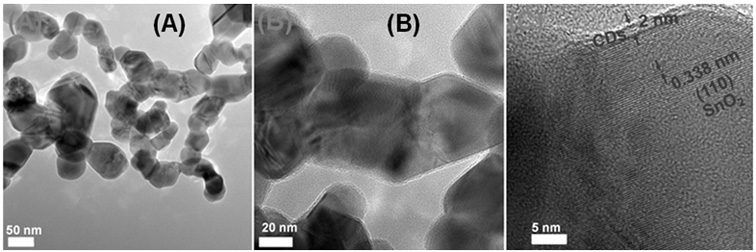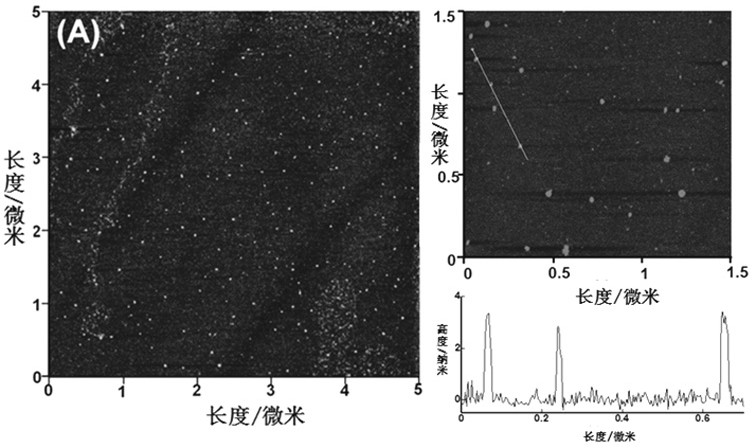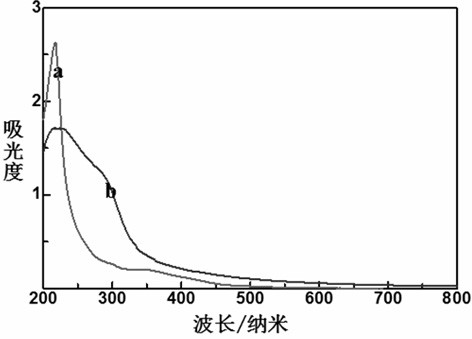Preparation of a carbon-based point-wrapped tin dioxide nanosheet composite and its application in surface-enhanced Raman substrates
A technology of surface-enhanced Raman and composite materials, which is applied in the directions of Raman scattering, material analysis, and material excitation analysis, can solve the problems of limiting the development of noble metal nano-substrates, weak spectral signal reproducibility, and unstable structural properties. Broaden the range of materials used, facilitate mechanism research, and have good product stability
- Summary
- Abstract
- Description
- Claims
- Application Information
AI Technical Summary
Problems solved by technology
Method used
Image
Examples
Embodiment 1
[0032] Weigh 1.8 g of single-layer graphene nanosheets with a diameter of <5 nm and dissolve them in 30 mL of water, adjust the pH to 8 with sodium hydroxide, then add 0.6 g of nano-tin dioxide solids to the above solution and mix, and the resulting mixed solution is 300W ~700W ultrasonic for 3~4 h, centrifuge at 3000 rpm for 10 min, collect the supernatant, then centrifuge the collected supernatant at 12000 rpm for 10 min, repeat centrifugation and washing 5 times until the supernatant is clear, the obtained The precipitate was dissolved in 10 mL of secondary water, that is, the carbon-based dot-wrapped tin dioxide nanosheet composite material, and stored in a refrigerator at 4 °C.
Embodiment 2
[0034] Weigh 1.2 g of single-layer graphene nanosheets with a diameter of <5 nm and dissolve them in 30 mL of water, adjust the pH to 8 with sodium hydroxide, then add 0.6 g of nano-tin dioxide solids to the above solution and mix, and the resulting mixed solution is 300W After ~700W ultrasonication for 3~4 h, centrifuge at 3000 rpm for 10 min, collect the supernatant, then centrifuge the collected supernatant at 12000 rpm for 10 min, and repeat the centrifugation and washing for 5 times until the supernatant is clear. The precipitate was dissolved in 10 mL of secondary water, that is, the carbon-based dot-wrapped tin dioxide nanosheet composite material, and stored in a refrigerator at 4 °C.
Embodiment 3
[0036] Weigh 0.6 g of single-layer graphene nanosheets with a diameter of <5 nm and dissolve them in 30 mL of water, adjust the pH to 8 with sodium hydroxide, then add 0.6 g of nanometer tin dioxide solids to the above solution and mix to obtain a mixed solution After ultrasonication at 300W~700W for 3~4h, centrifuge at 3000rpm for 10min, collect the supernatant, then centrifuge the collected supernatant at 12000rpm for 10min, repeat centrifugation and washing 5 times until the supernatant is clear, and the obtained precipitate Dissolved in 10 mL of secondary water, the carbon-based dot-wrapped tin dioxide nanosheet composite material was stored in a refrigerator at 4 °C.
[0037] figure 1 Transmission electron microscope image of the carbon-based dot-wrapped tin dioxide nanosheet composite prepared in Example 3. It can be seen from the figure that the prepared carbon-based dot-wrapped tin dioxide nanosheets are flakes with a size of about 20-50 nm, and the nanosheets are sur...
PUM
| Property | Measurement | Unit |
|---|---|---|
| diameter | aaaaa | aaaaa |
| size | aaaaa | aaaaa |
| thickness | aaaaa | aaaaa |
Abstract
Description
Claims
Application Information
 Login to View More
Login to View More - R&D
- Intellectual Property
- Life Sciences
- Materials
- Tech Scout
- Unparalleled Data Quality
- Higher Quality Content
- 60% Fewer Hallucinations
Browse by: Latest US Patents, China's latest patents, Technical Efficacy Thesaurus, Application Domain, Technology Topic, Popular Technical Reports.
© 2025 PatSnap. All rights reserved.Legal|Privacy policy|Modern Slavery Act Transparency Statement|Sitemap|About US| Contact US: help@patsnap.com



